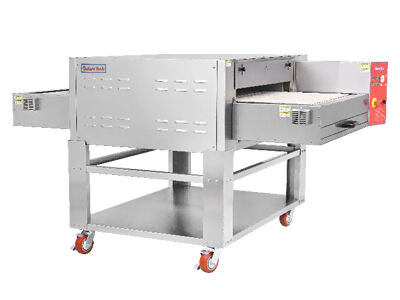Reengineering the Pizza Baking Experience: Innovative Design of Pizza Stone Conveyor Oven Based on the Current Catering Market
Building on traditional designs, pizza stone conveyor ovens continuously integrate innovative concepts to enhance performance and user experience.

Innovative Designs of Pizza stone conveyor ovens

1. Application Scenarios of Ovens
Special high-temperature-resistant stones are designed to distribute heat uniformly, ensuring that the pizza cooks evenly. This uniform heat distribution also helps in maintaining the structural integrity of the stone, preventing cracking and ensuring long-term durability. This makes the stone conveyor oven suitable for small and large pizza restaurants or fast-paced dining establishments.
2. Innovation in Combination of Deck Oven and Conveyor Oven
In pizza baking, traditional dome ovens use thermal radiation from high-temperature walls, while deck ovens rely on heat storage and conduction via multi-layered stone slabs. Though both make quality pizzas, they demand great chef expertise—from judging temperature differences in dome ovens and positioning pizzas when loading, to calculating deck oven batch times and adjusting dough placement. Even small operational errors cause inconsistent taste. By contrast, stone conveyor ovens ensure steady pizza quality, cut labor needs significantly, and are easier to use.
Pizza stone conveyor ovens standardize quality from the start through "stone slab heat retention + constant-speed chain conveyance". The chain moves pizzas at a fixed speed, so every pizza gets the same heating time and distance from the heat source. This removes the need for chefs to manually decide when to flip or take out pizzas.

Multi-Purpose Use: Beyond baking different types of pizza (Neapolitan, Italian thin-crust, American thick-crust), the stone conveyor oven can also cook focaccia bread, and more—improving equipment utilization.
Advantages of Pizza stone conveyor ovens
1. Superior Baking Results
The stone’s strong heat retention capacity allows the bottom of the pizza to set quickly, forming a crispy crust. Meanwhile, the high temperature inside the oven (usually 400–500°C) ensures that toppings (such as cheese) cook through rapidly, preserving the freshness, tenderness, and flavor of ingredients. This results in a taste much closer to that of professional pizza shops compared to ordinary stainless steel conveyor ovens. Additionally, ordinary deck ovens experience a sharp temperature drop when the door is opened to place pizza, and the temperature recovers slowly—easily leading to uneven baking, a problem avoided by pizza stone conveyor ovens.
2. Excellent Heat Conduction and Retention
The innovative, specially designed high-temperature-resistant stone simulates the "high-temperature conduction" principle of traditional pizza kilns (e.g., Neapolitan kilns), eliminating the inefficiency of "air heat transfer" in conventional ovens and laying the foundation for the pizza’s "crispy exterior and soft interior" texture. It also reduces the "local burning" issue common in traditional ovens—even thick-crust pizzas can be evenly cooked inside and out.
3. Energy and Cost Savings
Labor costs drop by 30% to 50%, and production capacity rises by over 50%. Even new operators can bake pizzas with the standard "crispy outside, soft inside, evenly stretchy cheese" texture—on par with those by senior chefs.

 EN
EN








































